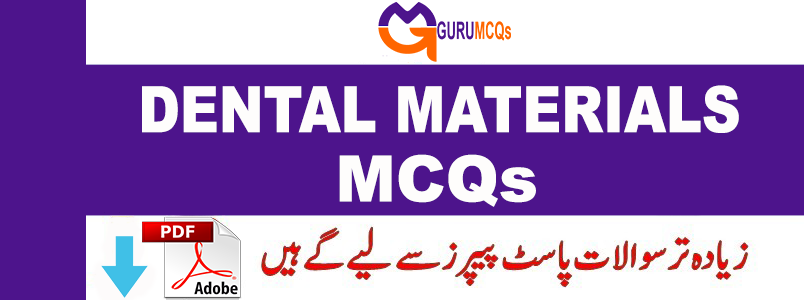
Dental impression materials, also known as dental materials, initially exist in a liquid or semi-solid state upon mixing and placement in the mouth. Over a few minutes, these materials undergo a setting process, transforming into an elastic solid. During this time, they capture an accurate imprint of an individual’s dentition and the surrounding structures within the oral cavity. GuruMCQs.com provides all updated Dental Materials MCQs. MCQs of dental materials content are updated regularly, with the addition of new topics, more questions, and useful links. Repeated dental materials MCQs consist of impression materials like Amalgams, Dental Cements, Direct Filling Gold, Gypsum Products MCQs, Impression Materials, Metallurgy, Physical Properties, Dental Ceramics & Miscellaneous, Restorative Resins – and much more. These multiple-choice questions (MCQs) in dental materials serve as valuable resources for various purposes such as interview preparation, entrance exams, competitive assessments, and certifications for individuals at all levels of experience, including experienced professionals, newcomers, and students. Additionally, you can find MCQs on oral histology for further exploration.
1. Dendrites in cst alloys form by mechanism of_________________?
A. Constitutional superconductivity
B. Constitutional supercooling
C. Constitutional supergriting
D. Constitutional supergraining
2. Compared with noble metals, base metals show_______________?
A. Increased hardness
B. Increased ductility
C. Better biocompatibility
D. Increased density
3. Mechanical properties of Cp Titanium are similar to alloys_____________?
A. Type III and Type IV gold
B. Type V and type VI gold
C. Type VII and type VIII gold
D. None of the above
4. The effects associated with cold working can be eliminated by a heat treatment called______________?
A. Age hardening heat treatment
B. Annealing heat treatment
C. Homogenization heat treatment
D. Solution heat treatment
5. With indirect spruing. Which one of the following porosities can be minimised_______________?
A. Back pressure porosity
B. Localized shrinkage porosity
C. Pin hole porosity
D. Micro porosity
6. The linear solidification shrinkage of Type IV Ni-Cr based alloys is_______________?
A. 2.3%
B. 1.56%
C. 1.37%
D. 3%
7. Which of the following cast gold alloys is used for fabricating partial denture frameworks______________?
A. Type I – Soft
B. Type II – Hard
C. Type III – Hard
D. Type IV – Extra Hard
8. Modern dental noble metal casting alloys generally have equiaxed fine grain structures because of the incorporation of small amounts of______________?
A. Chromium
B. Indium
C. Irridium
D. Palladium
9. Nickel is added to wrought gold alloys as______________?
A. Strengtherner
B. Hardener
C. Whitens the alloy
D. Scavenger
10. Stages of annealing in order_________________?
A. Recovery recrystallization grain growth
B. Recrystallization recovery, grain growth
C. Grain Growth Recrystallization recovery
D. Melting point, grain growth, Recrystallization
